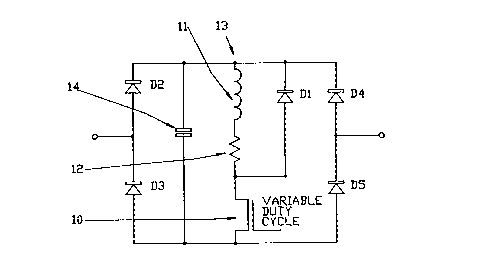Some of the information on this Web page has been provided by external sources. The Government of Canada is not responsible for the accuracy, reliability or currency of the information supplied by external sources. Users wishing to rely upon this information should consult directly with the source of the information. Content provided by external sources is not subject to official languages, privacy and accessibility requirements.
Any discrepancies in the text and image of the Claims and Abstract are due to differing posting times. Text of the Claims and Abstract are posted:
| (12) Patent: | (11) CA 2164819 |
|---|---|
| (54) English Title: | SOFT SWITCHING CIRCUITRY |
| (54) French Title: | CIRCUIT DE COMMUTATION ELECTRONIQUE |
| Status: | Expired and beyond the Period of Reversal |
| (51) International Patent Classification (IPC): |
|
|---|---|
| (72) Inventors : |
|
| (73) Owners : |
|
| (71) Applicants : |
|
| (74) Agent: | MARKS & CLERK |
| (74) Associate agent: | |
| (45) Issued: | 1998-11-10 |
| (86) PCT Filing Date: | 1994-06-14 |
| (87) Open to Public Inspection: | 1995-01-05 |
| Examination requested: | 1995-12-08 |
| Availability of licence: | N/A |
| Dedicated to the Public: | N/A |
| (25) Language of filing: | English |
| Patent Cooperation Treaty (PCT): | Yes |
|---|---|
| (86) PCT Filing Number: | PCT/NZ1994/000060 |
| (87) International Publication Number: | WO 1995001084 |
| (85) National Entry: | 1995-12-08 |
| (30) Application Priority Data: | ||||||
|---|---|---|---|---|---|---|
|
Switching circuitry for use with an autotransfortner for the smooth transition of voltage output from a circuit of either d.c. or a.c.,
between a higher and a lower voltage. The circuit includes at least one, preferably two, variable resistors (13) comprising a first solid state
switch (10), an inductor (11) and a resistor (12), in which the variable resistor (13) is connected to the conductance side of the switch and
wherein the circuit is connected to the voltage ouput of an autotransformer. If the solid state switch used are FETs the variable resistor
(13) is placed within a bridge rectifier (D2-D5). Transition time for movement of the voltage between two levels is approximately one
second.
Circuit de commutation d'autotransformateur, permettant une transition douce de la tension de sortie d'un circuit c.c. ou c.a. entre un niveau haut et un niveau bas. Le circuit comprend au moins un, et de préférence deux, résistances variables (13) comprenant un premier commutateur à semi-conducteurs (10), une bobine d'induction (11) et une résistance (12), la résistance variable (13) étant connectée au côté conductance du commutateur, et le circuit étant connecté à la sortie de tension d'un autotransformateur. Si les commutateurs à semi-conducteurs utilisés sont des FET, la résistance variable (13) est placée à l'intérieur d'un pont redresseur (D2-D5). Le temps nécessaire au passage de la tension entre deux niveaux est d'environ une seconde.
Note: Claims are shown in the official language in which they were submitted.
Note: Descriptions are shown in the official language in which they were submitted.

2024-08-01:As part of the Next Generation Patents (NGP) transition, the Canadian Patents Database (CPD) now contains a more detailed Event History, which replicates the Event Log of our new back-office solution.
Please note that "Inactive:" events refers to events no longer in use in our new back-office solution.
For a clearer understanding of the status of the application/patent presented on this page, the site Disclaimer , as well as the definitions for Patent , Event History , Maintenance Fee and Payment History should be consulted.
| Description | Date |
|---|---|
| Inactive: IPC from MCD | 2006-03-12 |
| Inactive: IPC from MCD | 2006-03-12 |
| Inactive: IPC from MCD | 2006-03-12 |
| Inactive: IPC from MCD | 2006-03-12 |
| Inactive: IPC from MCD | 2006-03-12 |
| Time Limit for Reversal Expired | 2001-06-14 |
| Letter Sent | 2000-06-14 |
| Inactive: Entity size changed | 1999-06-23 |
| Grant by Issuance | 1998-11-10 |
| Pre-grant | 1998-06-17 |
| Inactive: Final fee received | 1998-06-17 |
| Letter Sent | 1997-12-19 |
| Notice of Allowance is Issued | 1997-12-19 |
| Notice of Allowance is Issued | 1997-12-19 |
| Inactive: Status info is complete as of Log entry date | 1997-12-16 |
| Inactive: Application prosecuted on TS as of Log entry date | 1997-12-16 |
| Inactive: Approved for allowance (AFA) | 1997-12-08 |
| All Requirements for Examination Determined Compliant | 1995-12-08 |
| Request for Examination Requirements Determined Compliant | 1995-12-08 |
| Application Published (Open to Public Inspection) | 1995-01-05 |
There is no abandonment history.
The last payment was received on 1998-06-11
Note : If the full payment has not been received on or before the date indicated, a further fee may be required which may be one of the following
Please refer to the CIPO Patent Fees web page to see all current fee amounts.
| Fee Type | Anniversary Year | Due Date | Paid Date |
|---|---|---|---|
| MF (application, 3rd anniv.) - standard | 03 | 1997-06-16 | 1997-06-13 |
| MF (application, 4th anniv.) - standard | 04 | 1998-06-15 | 1998-06-11 |
| Final fee - standard | 1998-06-17 | ||
| MF (patent, 5th anniv.) - small | 1999-06-14 | 1999-06-14 |
Note: Records showing the ownership history in alphabetical order.
| Current Owners on Record |
|---|
| SOUTHPOWER LIMITED |
| Past Owners on Record |
|---|
| DAVID LESLIE LLOYD PEACH |